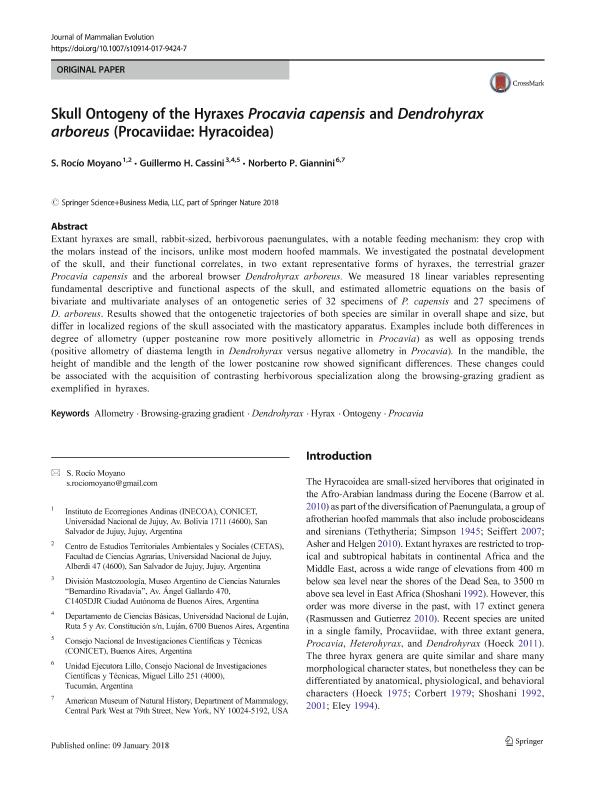Artículo
Skull ontogeny of the Hyraxes Procavia capensis and Dendrohyrax arboreus (Procaviidae: Hyracoidea)
Fecha de publicación:
01/2018
Editorial:
Springer
Revista:
Journal of Mammalian Evolution
ISSN:
1064-7554
Idioma:
Inglés
Tipo de recurso:
Artículo publicado
Clasificación temática:
Resumen
Extant hyraxes are small, rabbit-sized, herbivorous paenungulates, with a notable feeding mechanism: they crop with the molars instead of the incisors, unlike most modern hoofed mammals. We investigated the postnatal development of the skull, and their functional correlates, in two extant representative forms of hyraxes, the terrestrial grazer Procavia capensis and the arboreal browser Dendrohyrax arboreus. We measured 18 linear variables representing fundamental descriptive and functional aspects of the skull, and estimated allometric equations on the basis of bivariate and multivariate analyses of an ontogenetic series of 32 specimens of P. capensis and 27 specimens of D. arboreus. Results showed that the ontogenetic trajectories of both species are similar in overall shape and size, but differ in localized regions of the skull associated with the masticatory apparatus. Examples include both differences in degree of allometry (upper postcanine row more positively allometric in Procavia) as well as opposing trends (positive allometry of diastema length in Dendrohyrax versus negative allometry in Procavia). In the mandible, the height of mandible and the length of the lower postcanine row showed significant differences. These changes could be associated with the acquisition of contrasting herbivorous specialization along the browsing-grazing gradient as exemplified in hyraxes.
Palabras clave:
ALLOMETRY
,
BROWSING-GRAZING GRADIENT
,
DENDROHYRAX
,
HYRAX
,
ONTOGENY
,
PROCAVIA
Archivos asociados
Licencia
Identificadores
Colecciones
Articulos(MACNBR)
Articulos de MUSEO ARG.DE CS.NAT "BERNARDINO RIVADAVIA"
Articulos de MUSEO ARG.DE CS.NAT "BERNARDINO RIVADAVIA"
Articulos(UEL)
Articulos de UNIDAD EJECUTORA LILLO
Articulos de UNIDAD EJECUTORA LILLO
Citación
Moyano, Silvana Rocio; Cassini, Guillermo Hernán; Giannini, Norberto Pedro; Skull ontogeny of the Hyraxes Procavia capensis and Dendrohyrax arboreus (Procaviidae: Hyracoidea); Springer; Journal of Mammalian Evolution; 26; 3; 1-2018; 317–331
Compartir
Altmétricas




